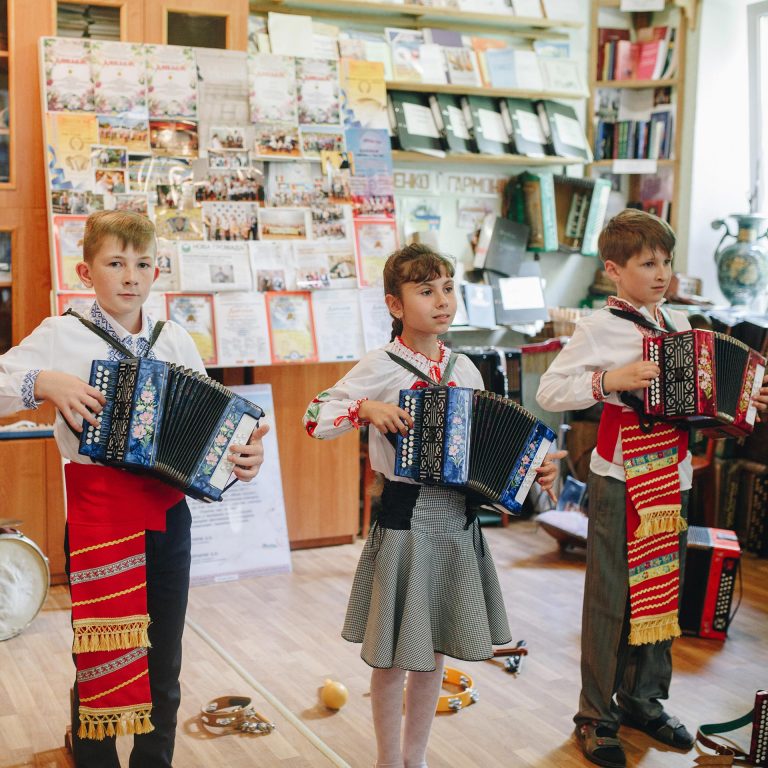The town of Zhashkiv is home to one of the biggest collections of accordions in Ukraine. Ivan Sukhyi works on the second floor of the town’s music school: since 1991, he has been leading the children’s accordion ensemble, which has traveled to 12 countries. Ukraine’s only accordion museum is here too; the collection has around five hundred exhibits, some of which are over a hundred years old. All are in working order and can be played by any visitor to the museum.
Professional musician Ivan Sukhyi has been teaching children to play the accordion for many years. At some point, he realised that simply playing was not enough: what he needed was a multi-angle approach. He then started to collect instruments. By 1991, he had collected so many that the music school (where Ivan worked) offered to open an exhibition room.

Ivan explains why the museum is unique: the instruments aren’t just there to be looked at, but can also be played:
– Right now this is the only accordion museum in Ukraine; it’s in the Ukrainian Book of Records. Why is that? Because it’s a multifunctional museum. Because you know that in any local history museum, everything is behind glass, nothing can be touched. In our museum, everything is open: it’s a place dedicated to pure, living, organic sound. That’s one distinguishing feature of this museum. It’s also the base of the Ukrainian accordionists’ ensemble — 26 to 28 people.
As time went by, the collection grew; the museum, which had initially fit into one room, expanded:
– I realized that I had to gather material, and delve into the history. And I kept on and on, collecting instruments, until I’d gathered so many that I had to open a museum. It turns out that the children are happy too, which is nice for me. It’s a job that makes you smile: if they enjoy it, then I feel good too.
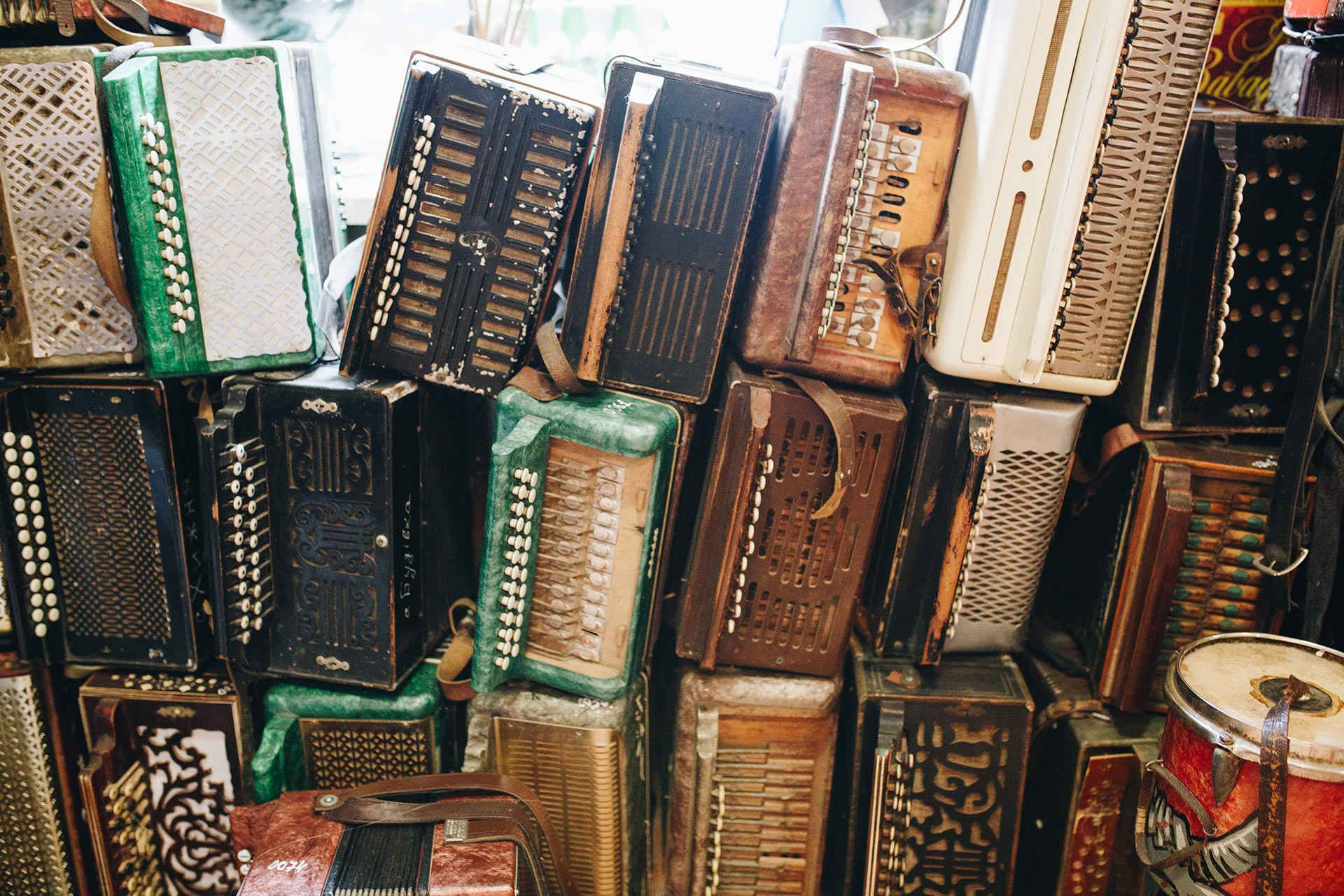
Folk Instrument
The accordion came to Ukraine from Russia at the turn of the nineteenth and twentieth centuries. According to experts, this instrument — consisting of two parts, connected by a bellows — appeared in the 1820s and spread very quickly. The accordion was popular among village dwellers in Ukraine; it was used to play humorous songs, or chastivky (four-lined comic folk songs, traditional in Ukraine and Russia — ed.). The instrument was even adapted to the vocal-instrumental folk tradition particular to Ukraine, for performing songs, dumas (folk ballads — ed.) and religious verses or psalms.
Ivan Sukhyi led an orchestra of Russian folk instruments up until 1991; then he decided to bring in the accordion. He taught one boy to play it, and quickly attracted the interest of others; soon enough, he had a group of eight students. Ivan’s father helped him to make a drum for them. Later, the group was invited to participate in the inter-republican children’s festival in Khmelnytskyi.
— The director called me and asked what I could bring. I had the orchestra and the accordionists. So I took the accordionists, added the drums, and the resulting ensemble was awarded a prize in this competition. It was a great start. Since then, we’ve been working in the same way.
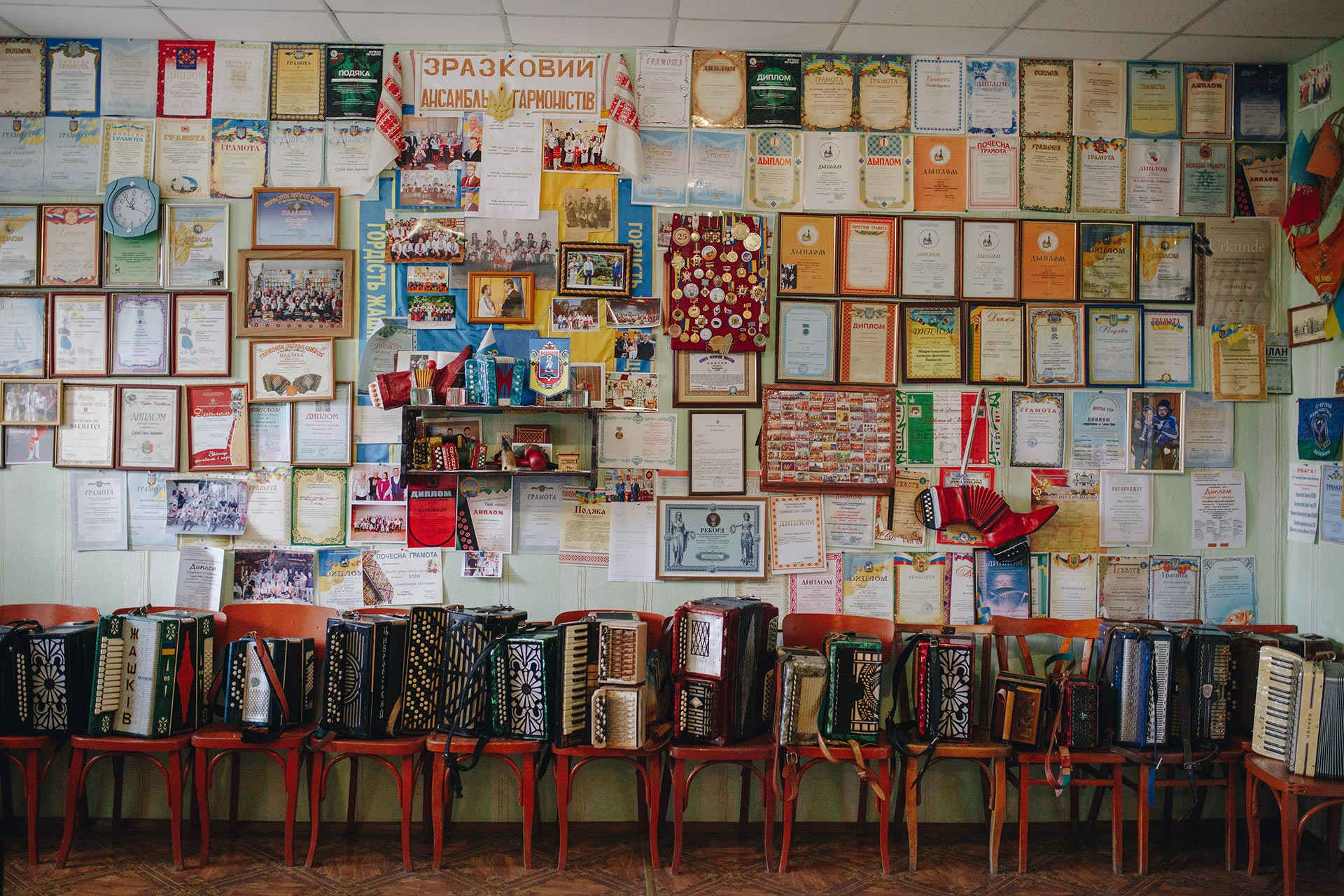
The following year, the ensemble came to the competition better prepared, but did not win a prize. The judges argued that the accordion was not a Ukrainian instrument and never had been. Ivan was outraged by this; he says there was an accordion in every Ukrainian village:
— I was upset by their disdainful response, because this really is a folk instrument. Ever since then — since 1991 — I haven’t played any Russian songs on the accordion, only Ukrainian ones. And, thank God, we’ve been doing this for 28 years. We’ve won prizes in 132 competitions, of which 38 were nationwide or international ones. In 28 years I’ve taught more than 250 children to play the accordion, and we’ve travelled to 12 European countries.
This type of accordion — known in Ukrainian as a harmon, or harmonika — is the predecessor of the bayan (button accordion — ed.) and the piano accordion. Ivan says its distinguishing feature is that it pushes the human body into movement:
— So the music starts, just the bass, but the person starts doing a little involuntary dance. This kind of muscle contraction is called innervation. No other instrument can do this. How do you make a person start dancing? You can’t force them! It comes right from the human soul, out of sincerity and simplicity. All brilliance comes from simplicity.
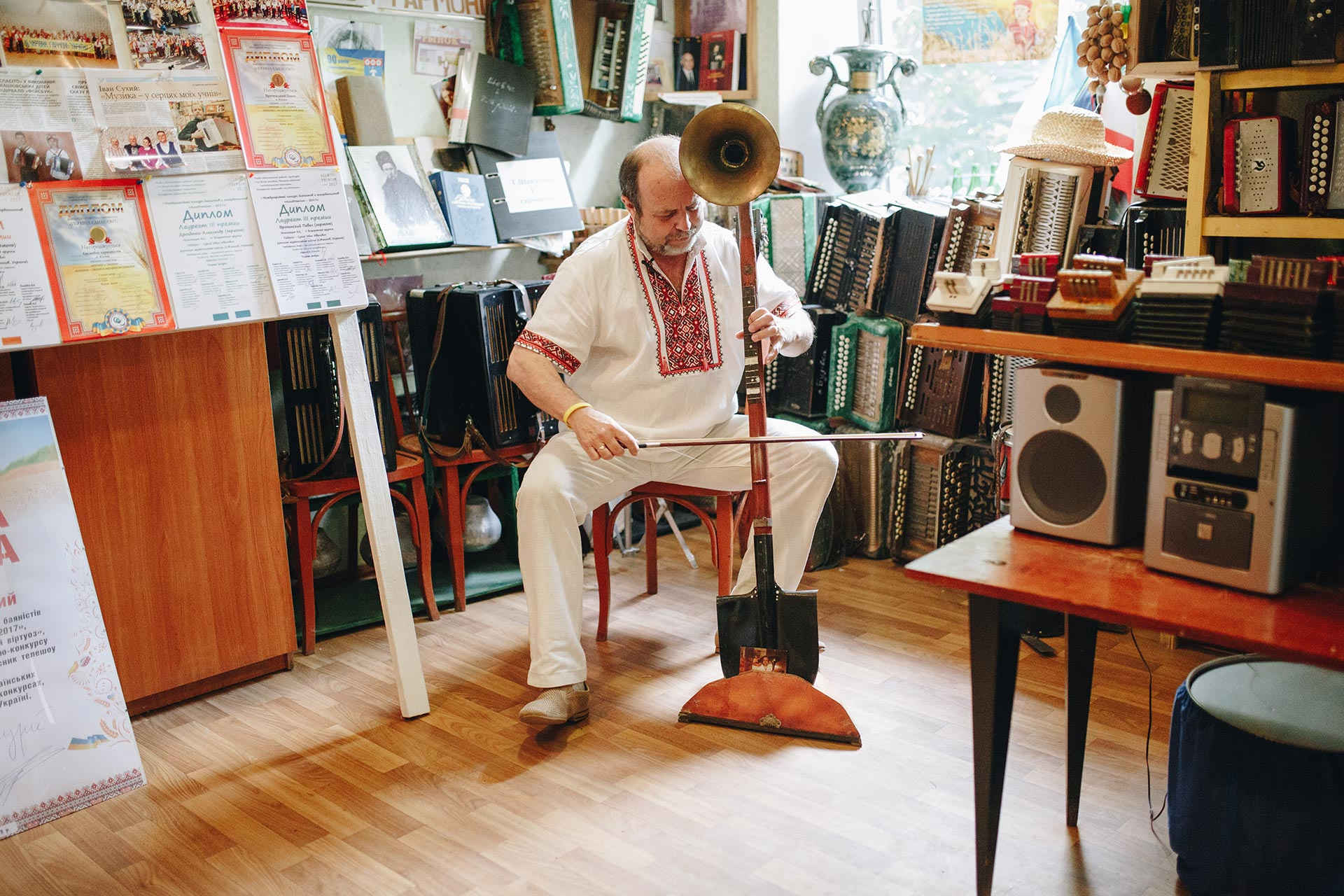
Pearls of the collection
Many different kinds of instruments find their way into the museum collection. Some were made by Ivan, by himself or with his father (who still works in the workshop at the age of 92). Some were found in villages, half-ruined; others, people brought in to donate:
— The harbakord is a combination of three different types of accordion — the harmon, the bayan and the piano accordion — and it’s amazing. We invented it ourselves — I dreamed it up. I wanted to play only on the left hand side of two instruments. My father, my brother and I took a whole summer — all of three months — to make it.
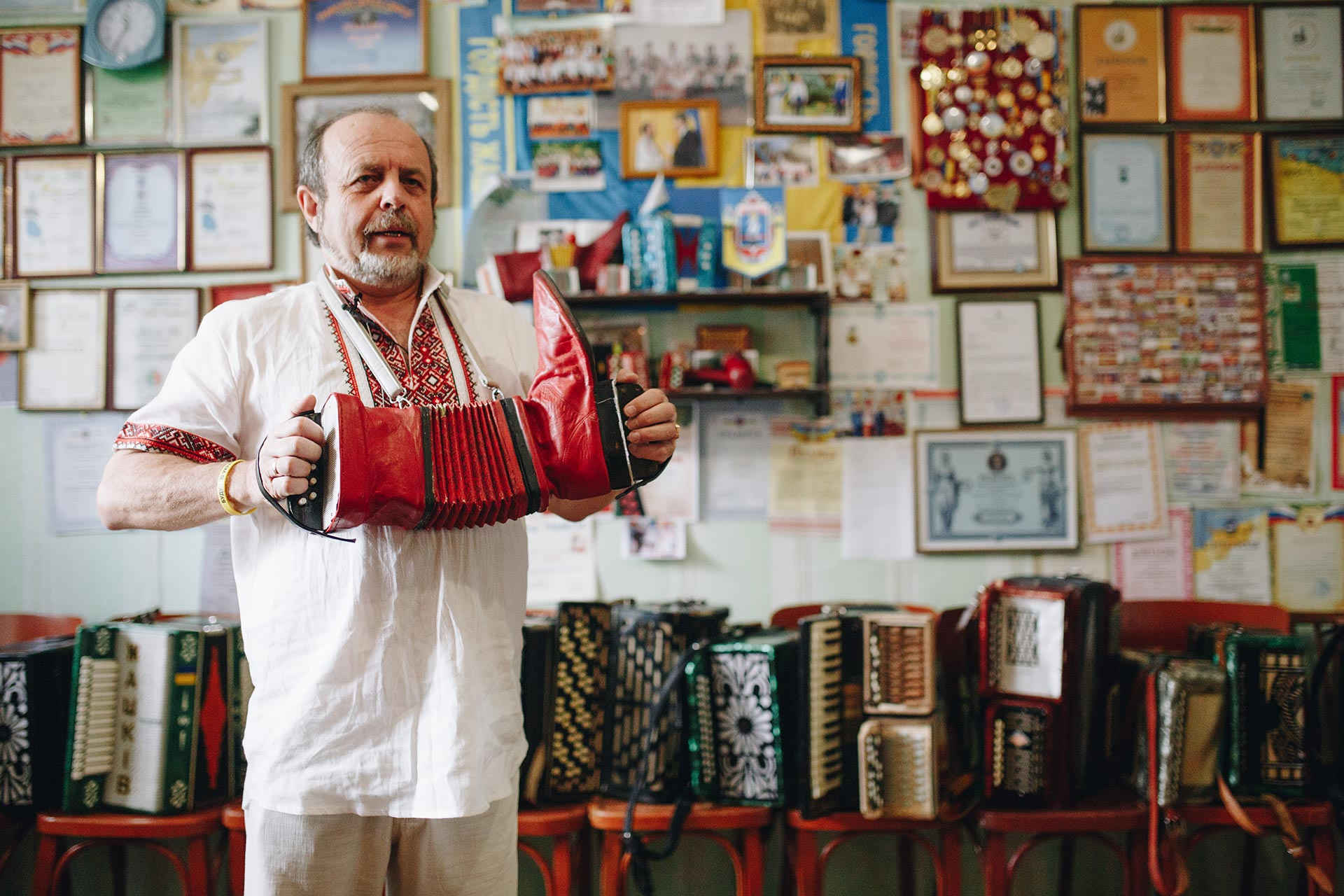
The first instrument Ivan Sukhyi created was a small accordion, made out of a woman’s boot. He had seen one on television, and his daughter asked him to make one like it. Another pearl of the collection is the reed organ, a unique, ancient instrument:
— I found it in a village, it had been lying out for years, getting soaked in the rain. I sent it to my father, who stored it under a canopy; it took four years to dry out. We renovated it: Bohdan Selchuk, my father and I. It has a flowing, vibrating sound; they don’t make them like that anymore. The instrument is about 200 years old. It’s our pride and joy — there’s an instrument like this in the Museum of Theatre Art in Kyiv, but it doesn’t work. The one in Pereiaslav-Khmelnytskyi doesn’t work either. But we had enough skills and knowledge to repair it and give it a new life. It works, and it’s a real antique piece in our collection.
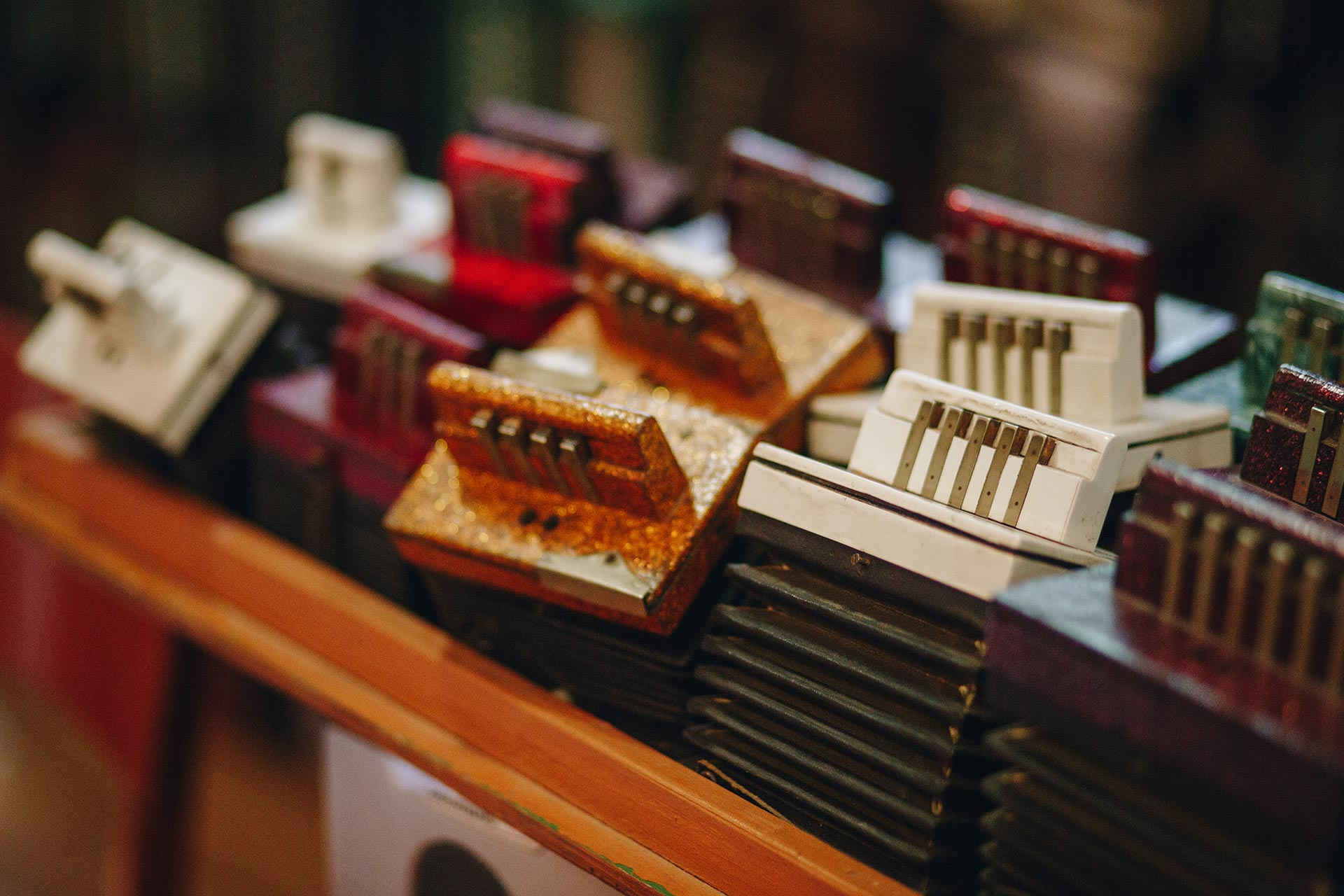
The museum also houses an instrument from the days of the Russian Empire. Ivan mentions a certain accordionist named Petronetskyi, from St. Petersburg. The tsar appreciated his musical talent so that instruments were made for him in the royal workshop. Ivan is very happy to have bought such a valuable piece:
— We had 19 accordions, each with a different sound. I bought another one, and now we have 20. When I got the instrument, if you pressed one way, you got the sound, and back — no sound, nothing at all. My father and I thought about it, and added one more voice: now you can play it back and forth and it produces a richer sound.
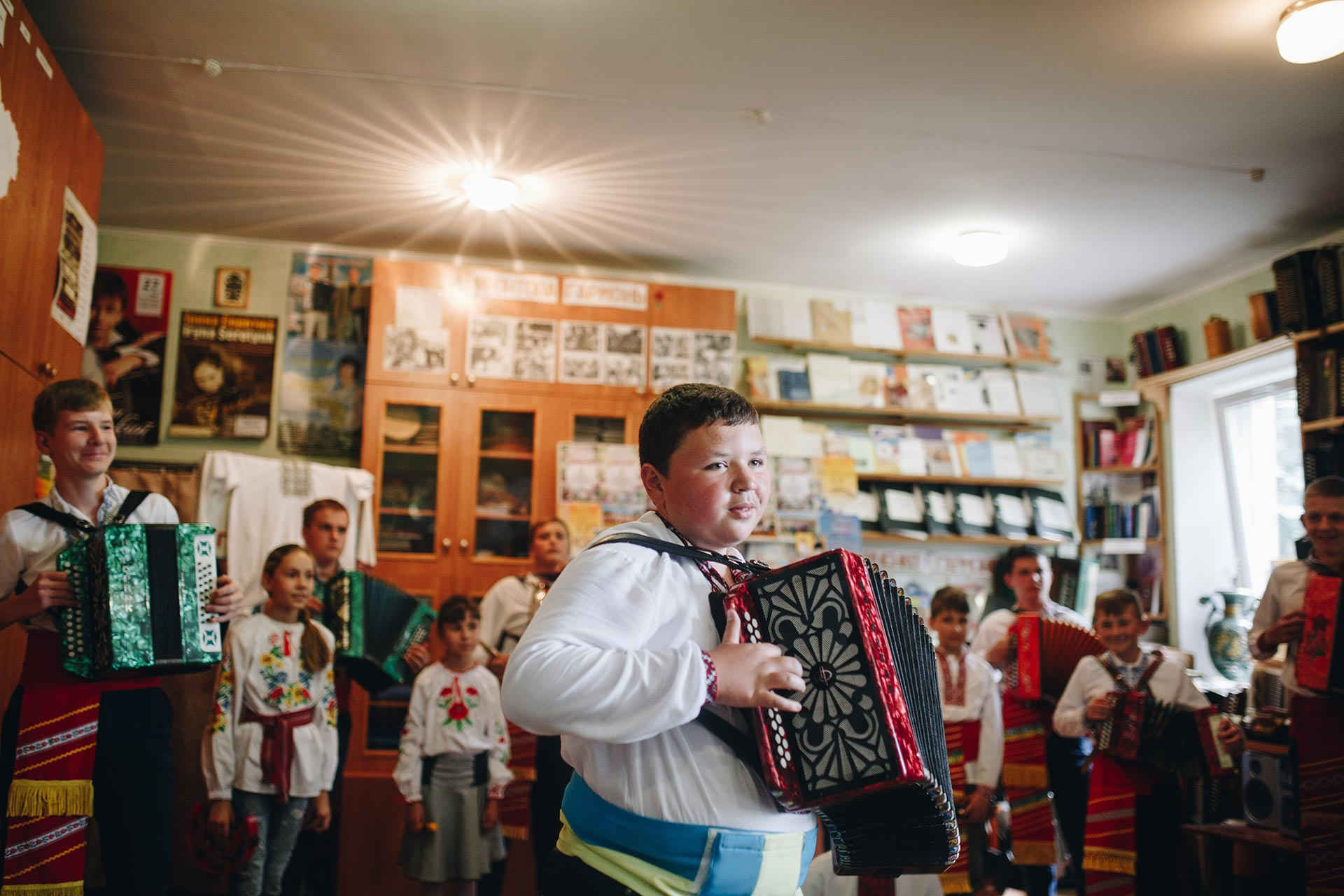
Accordion school
Ivan says he’s never bored by the accordion; he can even play for 13 hours in a row:
— I’m doing what I’ve loved since childhood. I graduated from college, joined the army, went to the institute, and gave classes at the music school. But all that wasn’t enough for me — I wanted to study. Then I went back to music school to study the balalaika. I completed a four-year programme in one year and became a balalaika teacher, but I don’t play it anymore. After that, I graduated from the international accordion school in St. Petersburg. I studied for 18 years and would love to keep on studying, because I enjoy it so much.
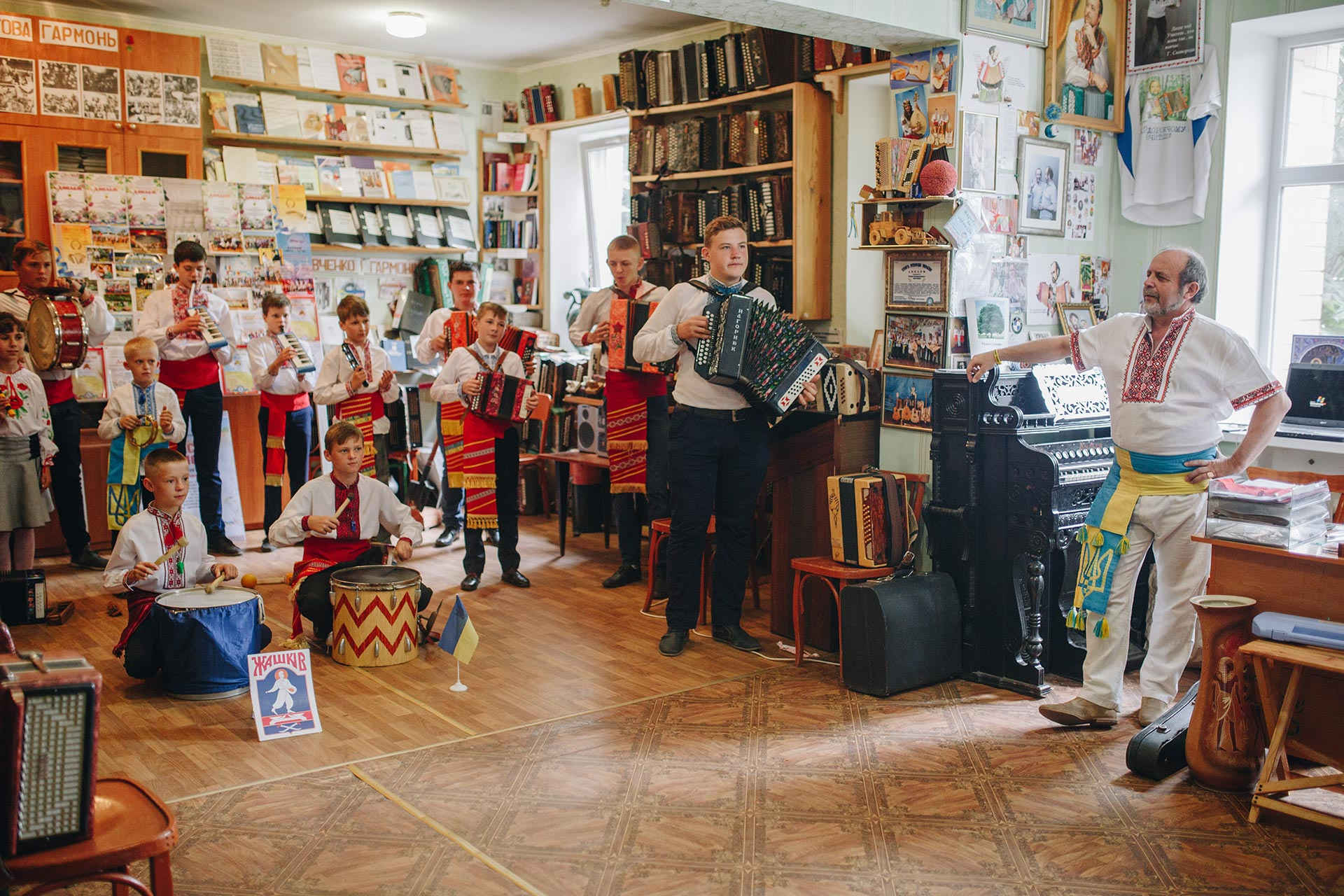
The music school in Zhashkiv celebrated its 60th anniversary in 2018. When Ivan started teaching children, the musical community in Zhashkiv did not believe anything would come of it. However, some of his students have gone on to become very successful:
— I have three prizewinning boys: one has won three international competitions, the other two have won five each. One of them, Pasha Vrochynskyi, even took part in the children’s version of Ukraine’s Got Talent. They have all received certificates awarded by the Association of Accordionists of Ukraine.
Ivan thinks that all his students should receive the accolade of “honoured accordionist of Ukraine”, but only when they really deserve it. He doesn’t worry that the children will become arrogant, as they all work hard. Each day, they go to bed aware of what they have achieved; the next morning, they wake up to a new start, and keep on doing what they’re good at.
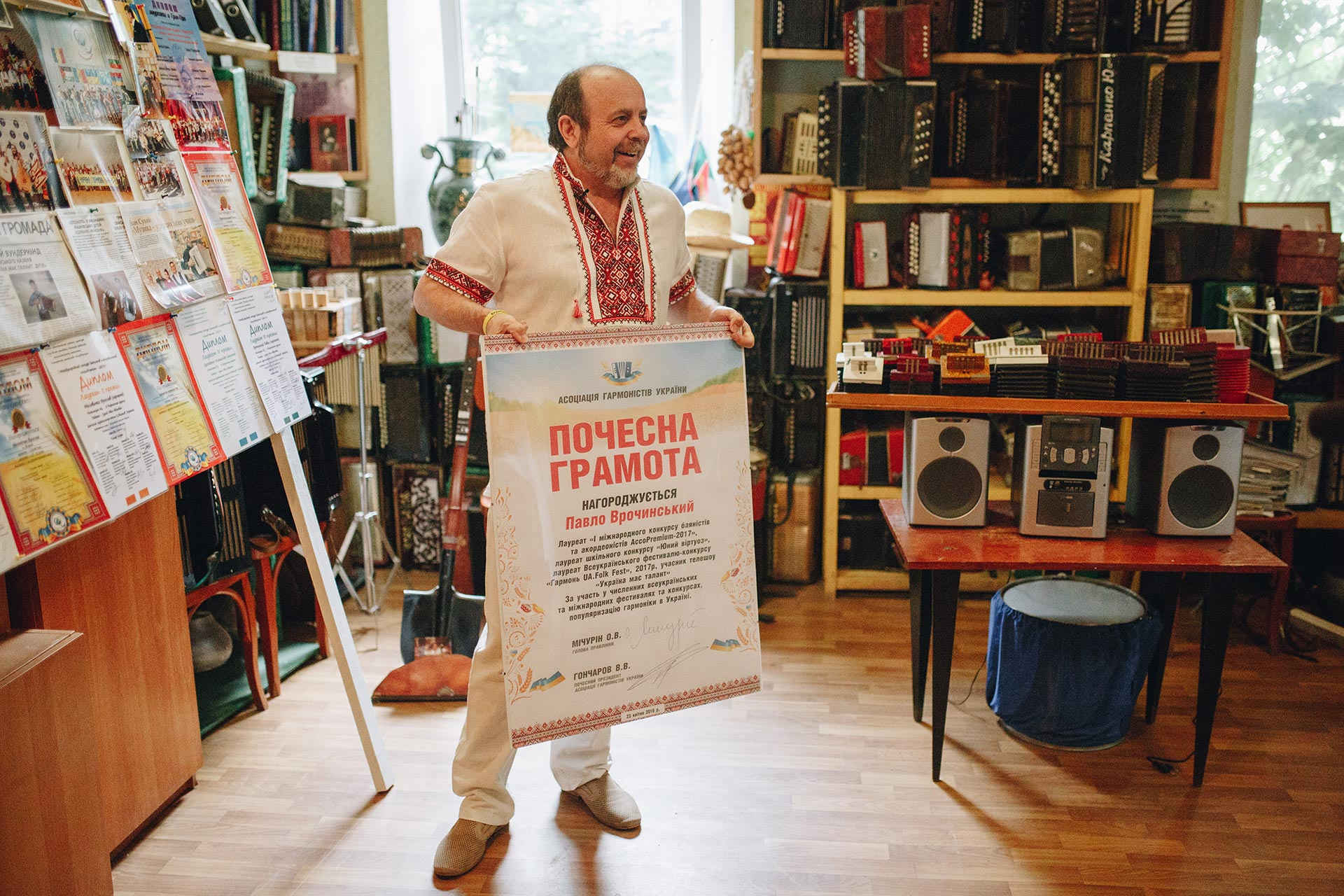
Ivan Sukhyi holds the title of “honoured cultural worker of Ukraine” and has also received several other orders of merit, including one from Poland. In 2004, Ivan — as the number two accordionist in Ukraine — received a presidential accordion from Viktor Yushchenko. He is pleased to have won these awards, but he is unwilling to rest on his laurels, preferring to keep on striving.
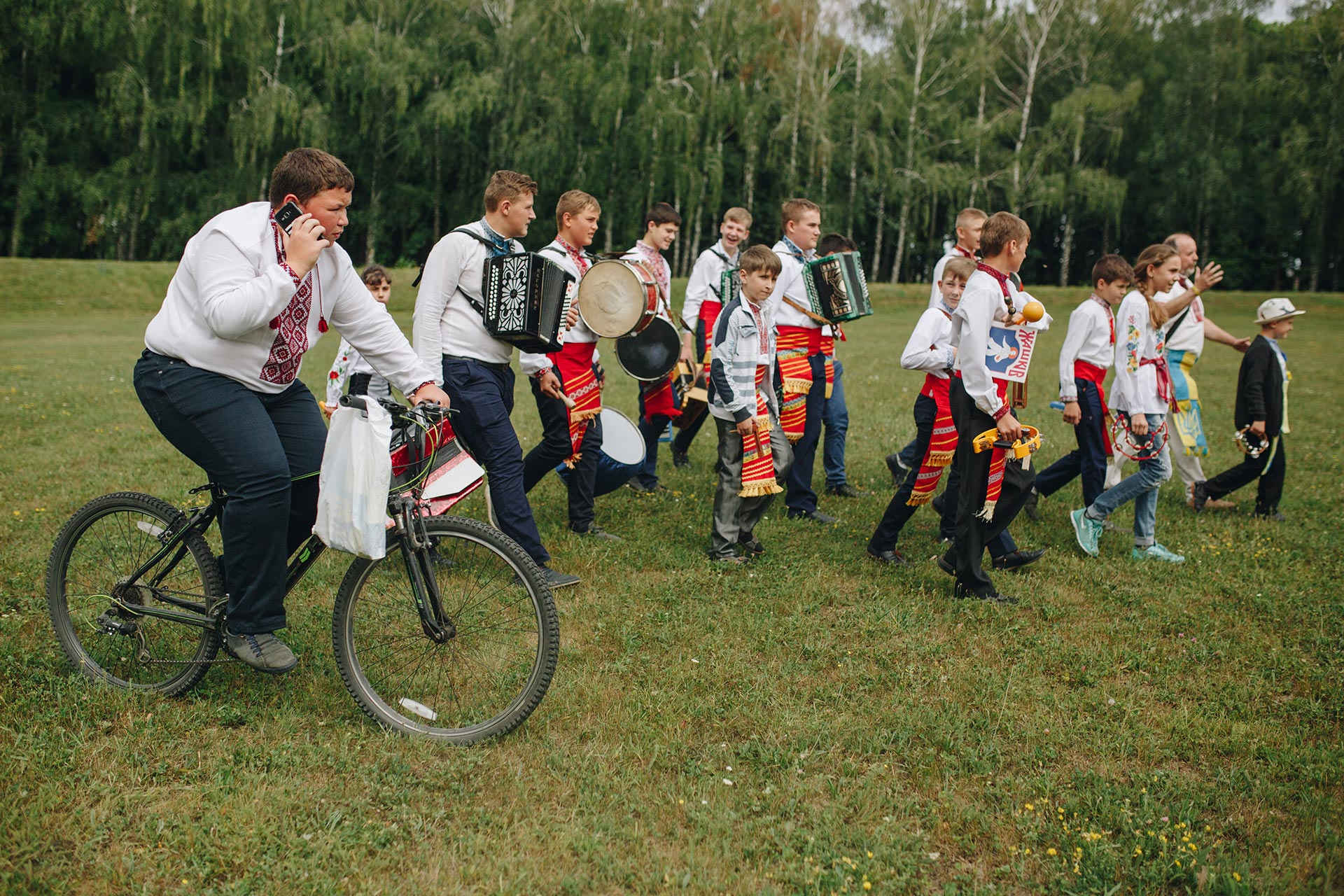
Ivan has constantly had to defend the accordion, to argue that it is worthy of a place among the Ukrainian instruments. In Ukraine he has performed in Kirovohrad (now called Kropyvnytskyi — tr.), Mykolaiv, and Kyiv; before the war, he also performed in Moscow, Novosibirsk, even Ufa. He says he made these trips in defence of the accordion. Russia is no longer on his itinerary:
— I stopped going to Russia in 2009. If they invite me, I say: dear Sirs, do you know what I do when I’m a member of the jury? I come and plant the Ukrainian flag and the Zhashkiv coat of arms. Can I do that now? That’s my answer. Do you want to break me? I won’t agree to this.
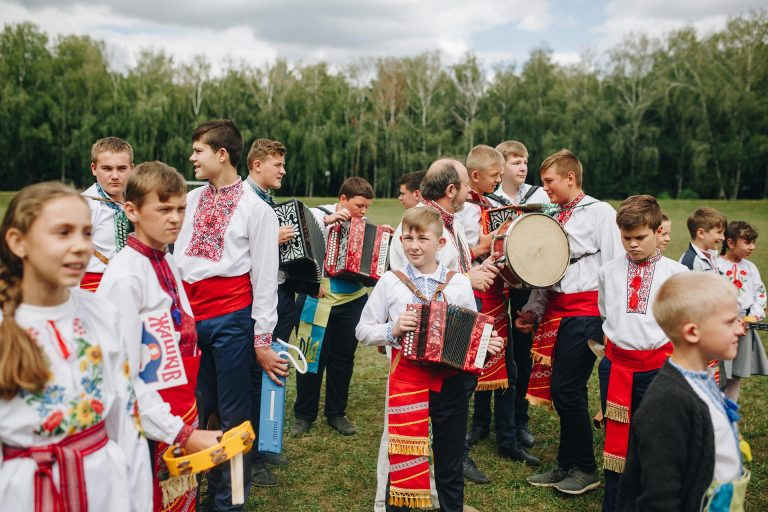
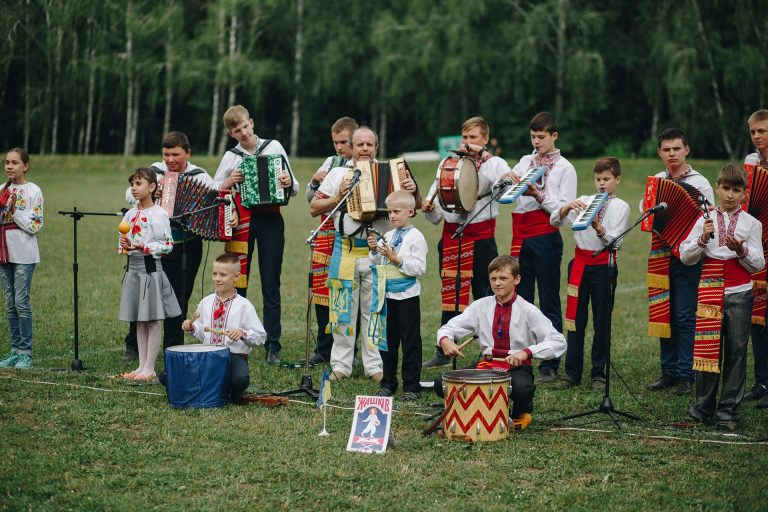
slideshow
At Zhashkiv music school, students are able to receive an official accordion diploma — the first of its kind in Ukraine. However, once this diploma is earned, there is nowhere to go for further study:
— In 2009, a student of mine finished the accordion course and wanted to continue studying. I took him to Orel, in Russia, where there’s a music college specialising in the accordion. He graduated from there and became Ukraine’s first professional accordion player. Now he’s studying the accordion at the conservatory in Moscow. He already plays better than me, but it remains to be seen whether or not he will be able to find a job in Ukraine. If they opened an accordion class somewhere here, at a music college, I would send him students from here. Then we could organise something together. But for now, it’s hard.
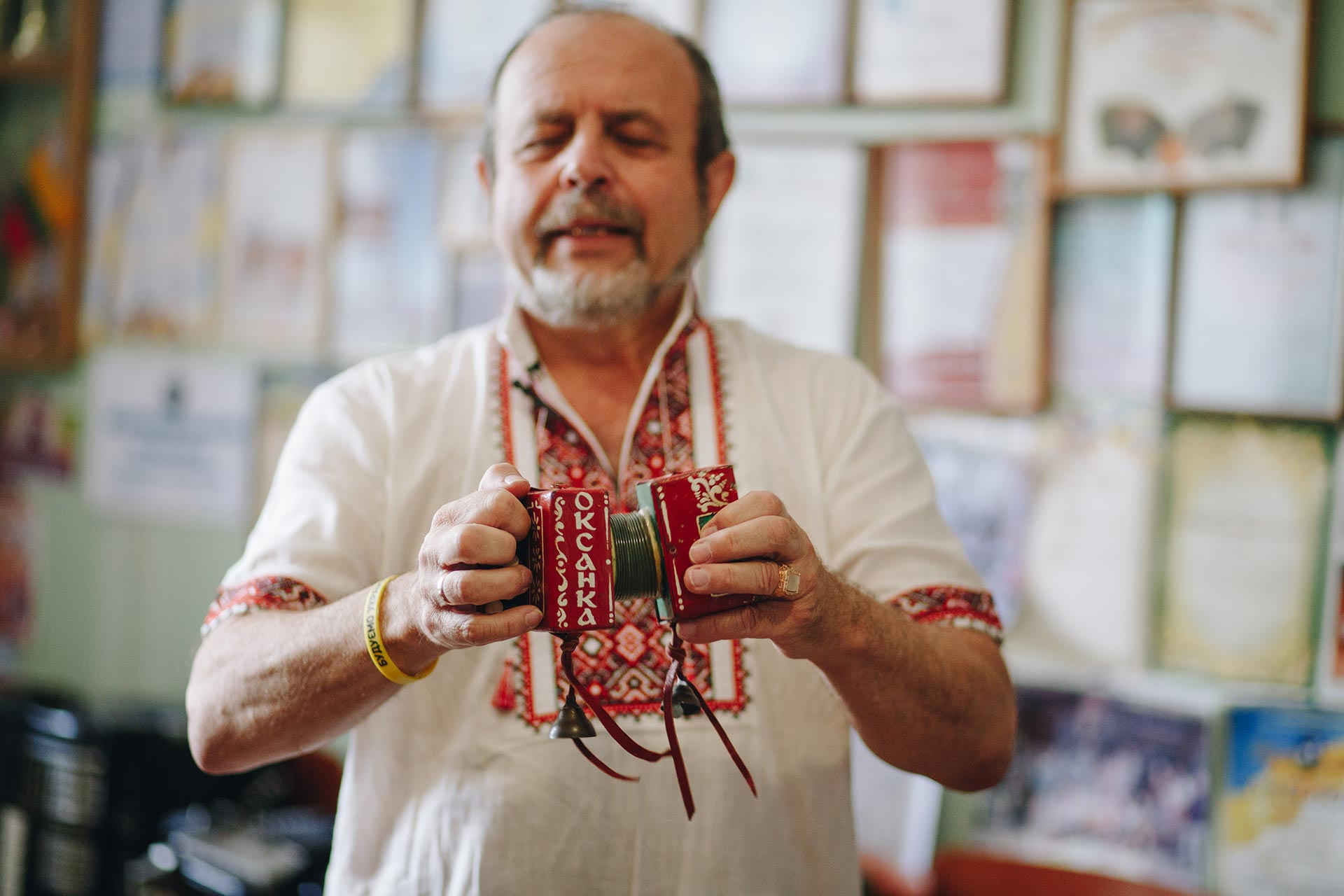
Record-breaking matchstick instruments
The museum collection also features instruments made out of matches, made by craftsman Bohdan Senchukov. Among his many matchstick creations (including a tractor), Senchukov has created 13 different musical instruments:
— Some time ago, a student from the music school made an accordion out of beads, so I said to Bohdan that it was time for us to combine our talents. Bohdan had already begun making a matchstick guitar. Then he brought a matchstick model of a button accordion — which wasn’t playable — and I brought him the best accordion that existed at that time. The result was this accordion: the basses are made out of matches, as well as the ribs inside.
The fingerboard alone is made up of 5,000 matches; 18,000 were needed to make the whole instrument. It has a symbolic name — “Unity”:
— With this accordion, I won second prize at the Lanciano accordion competition in Italy. It plays beautifully; it’s a high-quality instrument. He has made it many times over; he’s made that fingerboard several times. Distance is also an important factor here. This one has also made it into the record book. We even have a special date in the calendar — Matchstick Day.
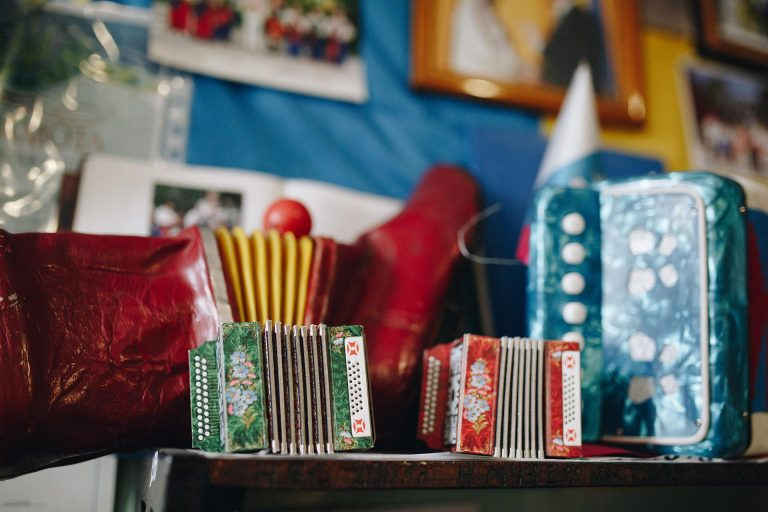
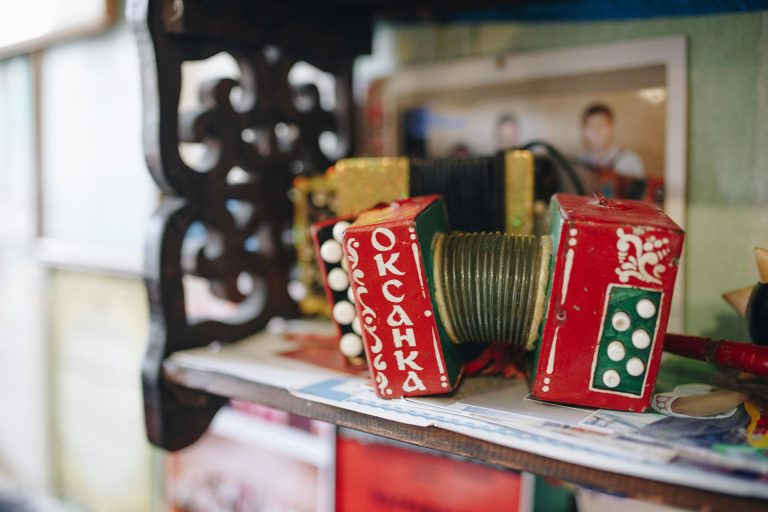
slideshow
In Kyiv, outside a restaurant, there is a sculpture of a matchstick. A festival of matchstick craft was held here, and craftspeople came from all over Ukraine to display their creations: there were ships, tractors, and cars, but Bohdan is the only one to have made matchstick instruments:
— Our instruments were played there, and our ensemble has made it into Ukraine’s National Register of Records. I found people to play these instruments, and we have the world’s only ensemble of matchstick instruments, created by craftsman Bohdan Senchukov and director Ivan Sukhyi. He’s a candidate for the Guinness Book of World Records. We know there’s a Hawaiian guitar in there, a souvenir rather than an instrument that can be played. But these instruments are fully playable.
So this is how one dedicated individual can create a whole museum of instruments, from 200-year-old antiques to home-made pieces, to one-off accordions such as the boot. These instruments can then be used to teach people to play, rather than hidden behind glass. With his love for music, Ivan Sukhyi has trained many aspiring musicians; more than anything, he has worked hard to preserve the tradition of accordion playing and make sure it continues into the future.

